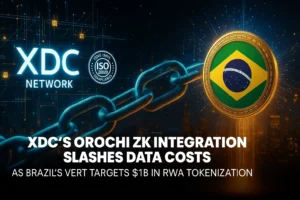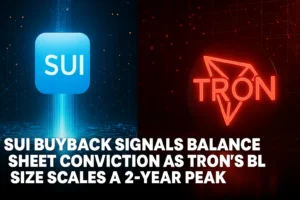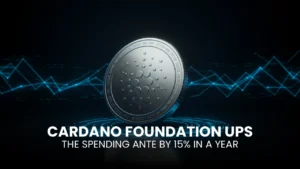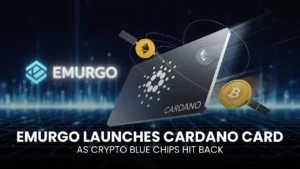Cathie Wood Sees BTC Price at $1.5M, Charles Hoskinson Talks $14B Cardano TVL, and XDC Network Gets ISO 20022 Compliance
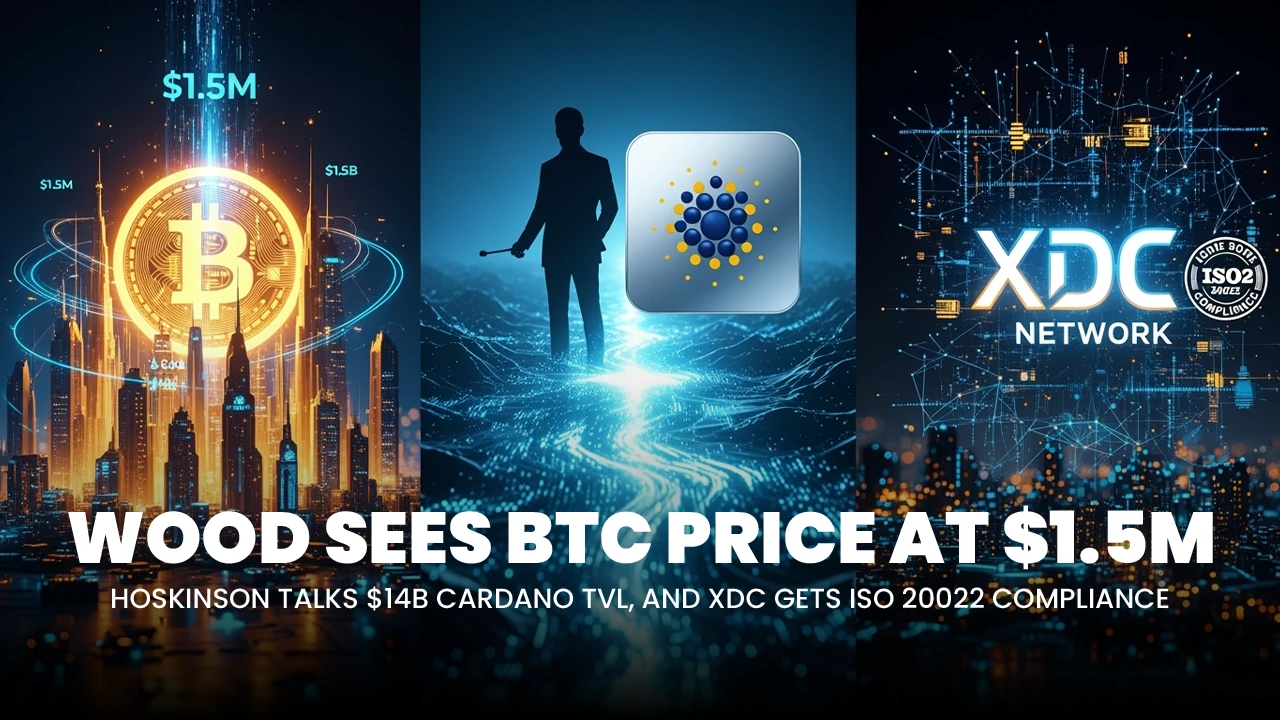
The cryptocurrency landscape is evolving at breakneck speed. Each week, new developments redefine how investors, institutions, and innovators see the role of Delegated Proof of Stake (DPoS)-powered blockchains in global finance. Three recent events have stood out for their influence and ambition: Cathie Wood of ARK Invest reaffirming her famous prediction that Bitcoin could one day hit $1.5 million, Cardano founder Charles Hoskinson sparking debate by suggesting that ADA’s real Total Value Locked (TVL) should be measured at $14 billion if staking is included, and the XDC Network joining the prestigious list of ISO 20022-compliant crypto projects.
Though these stories touch on different corners of the industry, together they paint a picture of an ecosystem maturing beyond speculation. Wood’s bullish stance illustrates the growing confidence from institutional investors who view Bitcoin not only as digital gold but also as a gateway into broader digital asset markets. Hoskinson’s bold claim reframes how we assess blockchain ecosystems, reminding everyone that metrics like TVL are not as straightforward as they appear. Meanwhile, XDC’s compliance milestone signals how crypto projects are integrating with global financial standards that could ultimately dictate which platforms thrive in the long run.
For investors, traders, and crypto watchers, these developments are more than just news headlines. They highlight where the next battles will be fought: regulatory adaptation, institutional recognition, and redefined measures of value. The interplay between these elements reveals a market striving for legitimacy, eager to prove its resilience, and determined to align with the larger systems that already move trillions of dollars every day.
Beneath these headlines lies a deeper theme; the role of Delegated Proof of Stake (DPoS) in shaping scalable, energy-efficient, and community-driven blockchains. While Proof of Work (PoW) chains once dominated the landscape with raw security, and Proof of Stake (PoS) has taken center stage in recent years, DPoS represents a practical evolution: it fuses decentralization with governance efficiency.
Let’s explore how Hoskinson’s vision, Wood’s confidence, and XDC’s regulatory leap all circle back to DPoS, whether directly through protocol mechanics or indirectly through philosophical alignment. DPoS isn’t just a consensus model; it’s becoming a narrative driver in its own right.
Cathie Wood’s ARK Invest: Betting on Bitcoin, Ethereum, and the Next Financial Frontier
Cathie Wood, founder and CEO of ARK Invest, has never shied away from bold predictions. Her most famous call—that Bitcoin could climb to $1.5 million in the coming years—continues to dominate headlines. While skeptics dismiss it as unrealistic, Wood has consistently tied her forecast to macroeconomic shifts, institutional adoption, and blockchain’s evolving role as a core pillar of financial infrastructure.
In her recent remarks, Wood emphasized that Bitcoin serves two main purposes: a store of value akin to digital gold, and a foundational entry point for institutions allocating digital assets. She acknowledged that stablecoins have captured a role once imagined for Bitcoin in emerging markets, but maintained that BTC’s long-term potential is only growing. In her view, the market is entering a phase where volatility will diminish as institutional capital anchors its valuation.
Ethereum also figures prominently in ARK Invest’s outlook. Despite Solana’s speed and market momentum, institutions are choosing Ethereum as their base layer. Coinbase, Robinhood, and Circle all continue to build on Ethereum, reinforcing its status as the backbone for stablecoins and decentralized finance. Wood sees Ethereum as the leading platform for the next generation of smart contracts, AI-driven microtransactions, and global settlement systems.
ARK Invest itself reflects this conviction with its core allocation strategy: Bitcoin, Ethereum, and Solana. Beyond crypto holdings, Wood’s equity picks—Coinbase, Circle, and Robinhood—form what she calls a “strategic triangle” that bridges traditional finance with digital assets. Transparency is central to her strategy. By publicly sharing ARK’s trades and research, she has turned transparency into a competitive advantage, attracting a global following of retail and institutional investors alike.
At the macro level, Wood also weighed in on the us economy. She believes the country is on the cusp of transitioning from a “rolling recession” to an “unexpected recovery,” driven by deflationary breakthroughs in AI, robotics, blockchain, and gene sequencing. High interest rates, she warns, could still trigger housing corrections, but the broader economy is heading into a period of creative destruction that favors innovators over incumbents.
Perhaps her most striking view is on AI. While some fear that artificial intelligence will overtake active investors, Wood argues the opposite. She believes AI will disrupt traditional quant strategies, commoditizing them, while firms like ARK—rooted in original research and forward-looking analysis—will thrive by integrating AI into their work. For her, the synergy of human insight and AI-driven tools is the key to outperforming markets in the next decade.
Taken together, Wood’s optimism reflects more than a prediction. It signals how institutional investors are reframing crypto, not as a speculative gamble, but as a cornerstone of future financial systems. In this sense, Wood’s bullishness underscores the logic behind DPoS-based and DPoS-aligned systems: they are not only faster but also better positioned to meet regulatory and institutional demands. Governance by delegation allows these networks to evolve quickly in response to legal frameworks while maintaining decentralization at their core.
To Wood, the crypto projects most likely to thrive will be those that merge speed and scalability with compliance-readiness, and it’s no coincidence that DPoS frameworks are increasingly becoming the consensus engine of choice for such ambitions.
Charles Hoskinson and the $14 Billion TVL Debate for Cardano
Charles Hoskinson, co-founder of Cardano and one of crypto’s most outspoken leaders, recently sparked debate with his claim that ADA’s true Total Value Locked should be calculated at around $14 billion. His reasoning: staking, a cornerstone of proof-of-stake networks, isn’t counted in conventional TVL metrics. If it were, he argues, Cardano’s ecosystem would be valued far higher than current data suggests.
This isn’t just a technical quibble—it’s a narrative play. TVL has long been the go-to metric for measuring DeFi ecosystems, popularized by Ethereum and later adopted by competitors like Solana, Avalanche, and Polygon. However, the calculation typically excludes staked tokens, which for Cardano, represent a massive share of its activity. By reframing the metric, Hoskinson is challenging the industry’s assumptions about what really reflects blockchain adoption.
The implications are significant. If Cardano’s staking were widely recognized as part of its TVL, ADA could immediately be perceived as one of the strongest DeFi ecosystems in terms of capital engagement. This would not only elevate Cardano’s status relative to Ethereum and Solana but also reshape investor sentiment about its long-term viability.
Critics, however, argue that staking should be treated separately, as it doesn’t always translate into liquidity available for DeFi protocols. TVL was designed to measure assets actively committed to lending, trading, or liquidity pools, not those locked in consensus mechanisms. From that perspective, including staking may inflate the numbers without providing a true picture of ecosystem health.
Hoskinson’s statement nevertheless highlights a broader conversation: how do we measure blockchain success? Traditional metrics like TVL, market cap, or even daily active users only capture parts of the story. For Cardano, which prides itself on research-driven development, scalability, and long-term sustainability, staking represents a vital component of its model. By pushing for recognition of that value, Hoskinson is attempting to rewrite the narrative in Cardano’s favor.
For investors, the debate matters. Metrics shape perception, and perception shapes price. If the industry begins to accept staking as part of TVL, ADA’s relative standing could improve dramatically, potentially sparking new capital inflows and renewed enthusiasm. Whether or not the broader market accepts Hoskinson’s reframing, the discussion underscores how fluid definitions remain in a fast-changing industry.
His bullish stance reflected a core belief — that community-driven governance (embodied by DPoS-style delegation) is the future of blockchain politics. The philosophy overlaps neatly: PoS ensures decentralization, but DPoS supercharges efficiency by streamlining validator participation without sidelining community voices.
For Cardano, Hoskinson believes this balance will enable it to withstand hype cycles and regulatory storms alike, positioning ADA as a cornerstone of long-term blockchain infrastructure.
XDC Network Joins Ripple, Hedera, and Algorand in ISO 20022 Compliance
While Cathie Wood and Charles Hoskinson spoke to vision and perception, the XDC Network made headlines for something more concrete: compliance. XDC officially joined Ripple, Hedera, and Algorand as one of the very few crypto projects aligned with ISO 20022, the new global standard for financial messaging. Alongside earlier adopters like Cardano, Stellar, Quant, and IOTA, that makes only eight cryptocurrencies globally that are compliant.
ISO 20022 is a big deal. It’s the backbone standard being adopted by banks and financial institutions worldwide to modernize cross-border payments and enhance interoperability. In short, it’s the plumbing of global finance. By achieving compliance, XDC positions itself not just as another blockchain project, but as an infrastructure-ready platform capable of integrating with the systems that already move trillions of dollars every day.
XDC’s focus on trade finance makes compliance especially powerful. The network specializes in tokenizing assets like us Treasuries and private credit, offering private subnetworks for sensitive institutional data. By combining confidentiality with regulatory alignment, it appeals directly to banks and enterprises looking for blockchain solutions that meet strict standards.
But here’s where DPoS plays a crucial role: XDC leverages a Delegated Proof of Stake consensus to achieve its performance benchmarks. With fast finality, low transaction fees, and high energy efficiency, DPoS allows XDC to support the volume and reliability required for cross-border finance. Unlike PoW chains that struggle with scalability, XDC’s DPoS structure ensures it can process thousands of transactions per second while still allowing token holders to influence governance by delegating their votes.
The use of DPoS is not incidental — it’s foundational. It’s what makes XDC capable of both satisfying institutional requirements and remaining attractive to its grassroots crypto community. By distributing decision-making power yet streamlining validation, XDC has engineered a balance that appeals to both compliance-driven enterprises and decentralization-focused crypto enthusiasts.
The announcement has sparked widespread bullish commentary, not only from investors like Cathie Wood but also from developers and community leaders across the crypto landscape. For many, XDC’s move is a proof point that DPoS-based systems are uniquely positioned to bridge the gap between decentralized innovation and centralized financial infrastructure.
ALSO READ: TRON Pulls $9.9B in USDT Out of Ethereum as Stablecoin Shift Gains Momentum
Conclusion
These three crypto events, Cathie Wood’s bullish strategy, Charles Hoskinson’s $14 billion TVL claim, and XDC’s compliance breakthrough, illustrate different but connected themes shaping crypto’s future. Wood underscores the institutional belief in Bitcoin and Ethereum as anchors of the digital asset economy. Hoskinson challenges how we measure value, pushing for recognition of staking as central to proof-of-stake ecosystems. XDC demonstrates how alignment with global financial standards can secure long-term relevance.
Together, they point to a single conclusion: crypto is maturing. No longer just a playground for retail speculation, the industry is embedding itself into the frameworks of traditional finance, redefining metrics of success, and preparing for institutional scale. Whether through bullish predictions, reframed narratives, or compliance milestones, the message is the same: the digital asset revolution is not slowing down—it’s accelerating.
The common denominator is Delegated Proof of Stake (DPoS). While not always explicitly named, the principles of DPoS — community governance, scalability, responsiveness, and energy efficiency — run like a thread through each story. Cardano’s governance ideals echo DPoS values, ARK’s compliance-first investment strategy favors DPoS-driven scalability, and XDC’s technical achievement is directly powered by DPoS mechanics.
If the last bull runs were about speculation, the next may be about adoption at scale. And in that world, DPoS is emerging as a consensus mechanism designed not just for the blockchain faithful but also for the institutions, regulators, and global systems that will shape crypto’s long-term destiny.
Frequently Asked Questions
Q1. What is Cathie Wood’s Bitcoin prediction?
She believes Bitcoin could surpass $1 million within five years, potentially hitting $1.5M.
Q2. Why does Charles Hoskinson argue Cardano’s TVL should be $14B?
He claims that including staking gives a more accurate reflection of Cardano’s ecosystem value.
Q3. What is ISO 20022?
It’s the global financial messaging standard being adopted by banks to modernize cross-border payments.
Q4. Which cryptos are ISO 20022-compliant?
Ripple, Hedera, Algorand, XDC, Cardano, Stellar, Quant, and IOTA.
Q5. Why does ISO compliance matter for cryptos?
It aligns them with global financial infrastructure, making them more attractive to institutions.
Glossary of Key Terms
- TVL (Total Value Locked): Assets locked in DeFi protocols.
- ISO 20022: Global financial messaging standard for banks and institutions.
- Stablecoins: Cryptos pegged to stable assets like the us dollar.
- On-Demand Liquidity (ODL): Ripple’s system for instant cross-border transfers.
- DeFi: Blockchain-based financial services outside traditional banks.
Disclaimer
This article is for informational purposes only and should not be considered financial advice. Cryptocurrency investments are highly volatile and carry significant risk. Readers should conduct their own research and consult with licensed professionals before making any financial decisions.

